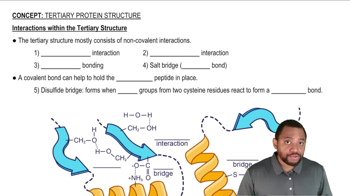Here are the essential concepts you must grasp in order to answer the question correctly.
tRNA Structure
Transfer RNA (tRNA) is a type of RNA molecule that helps decode a messenger RNA (mRNA) sequence into a protein. Each tRNA has a specific three-dimensional structure that includes an anticodon region, which pairs with the corresponding codon on the mRNA, and an amino acid attachment site. The unique structure of each tRNA allows it to carry a specific amino acid, which is essential for protein synthesis.
Recommended video:
Structural Formula Concept 2
Amino Acid Specificity
Each tRNA is linked to a specific amino acid, which is determined by the tRNA's anticodon sequence. The enzyme aminoacyl-tRNA synthetase catalyzes the attachment of the correct amino acid to its corresponding tRNA, ensuring that the right amino acid is incorporated into the growing polypeptide chain during translation. This specificity is crucial for maintaining the integrity of protein synthesis.
Recommended video:
Codon-Anticodon Interaction
The interaction between codons on the mRNA and anticodons on the tRNA is fundamental for the translation process. Each tRNA has an anticodon that is complementary to a specific mRNA codon, allowing it to recognize and bind to the correct sequence during protein synthesis. This interaction not only ensures the correct amino acid is added but also plays a role in the overall fidelity of translation.
Recommended video:
Interactions within the Tertiary Structure Concept 2
 Verified step by step guidance
Verified step by step guidance Verified video answer for a similar problem:
Verified video answer for a similar problem:



 1:42m
1:42m